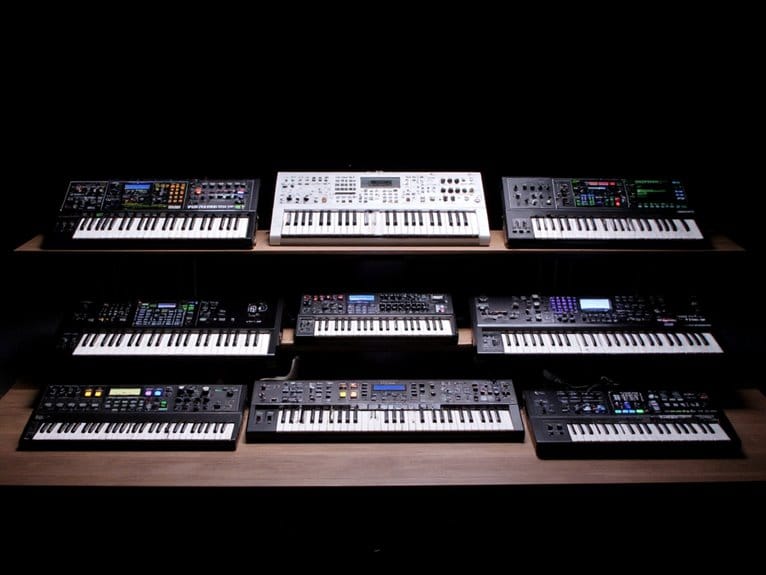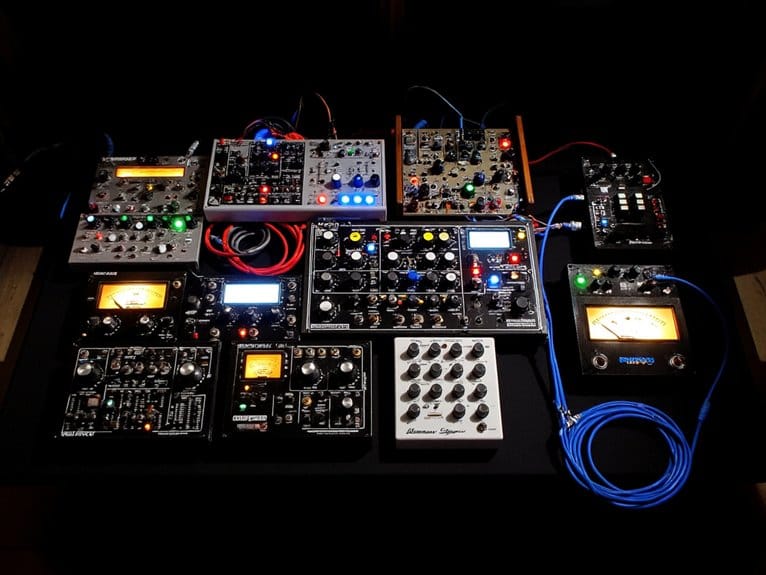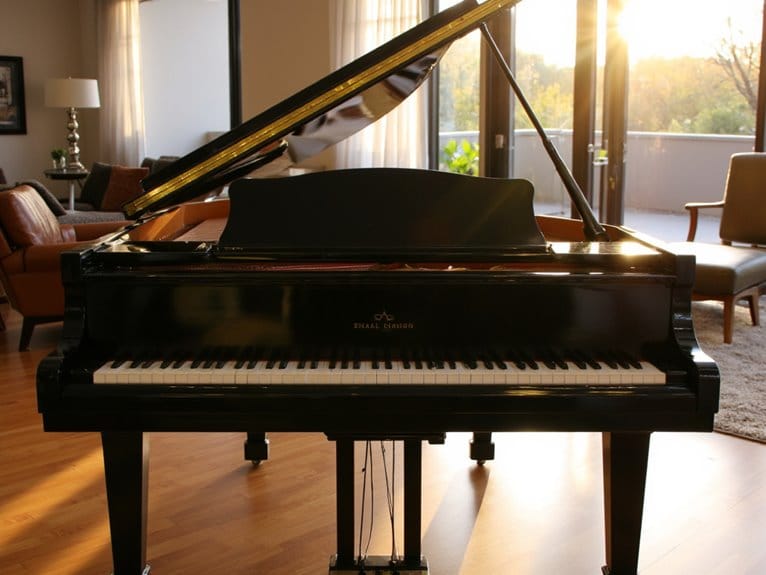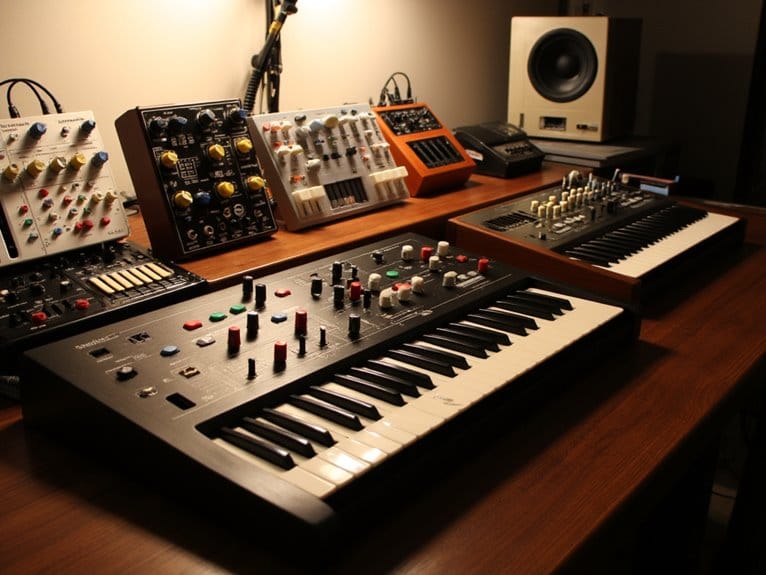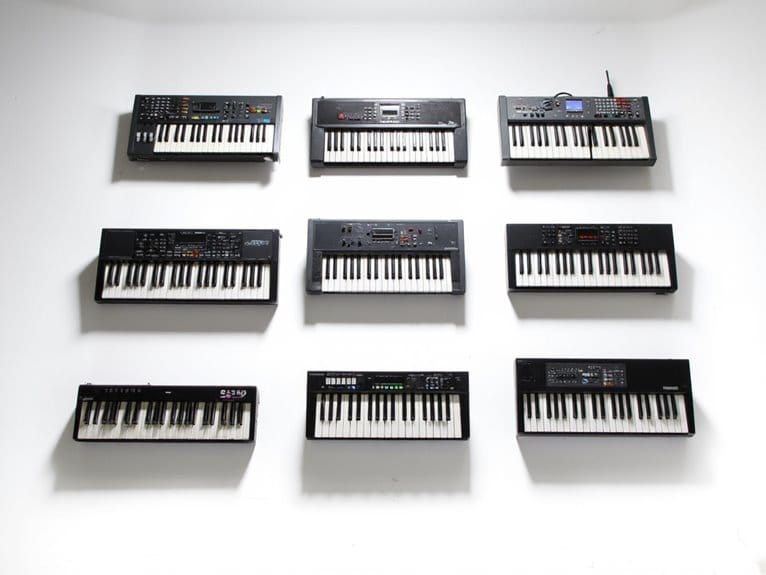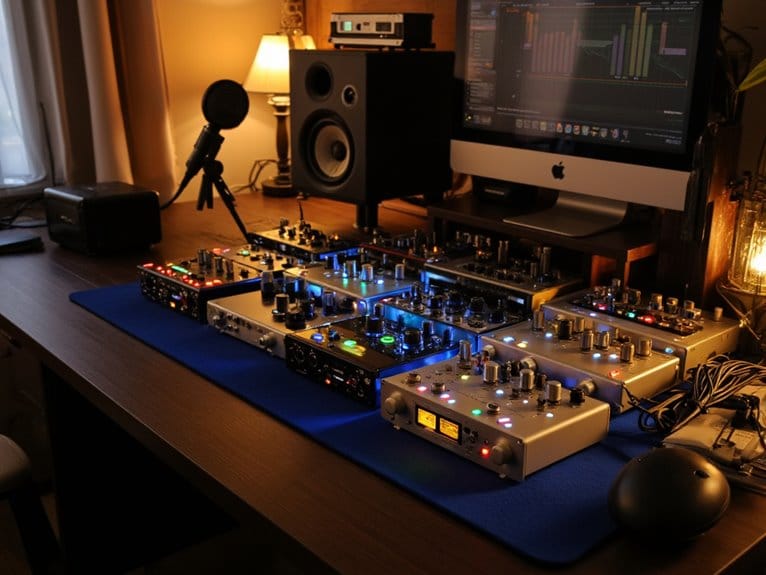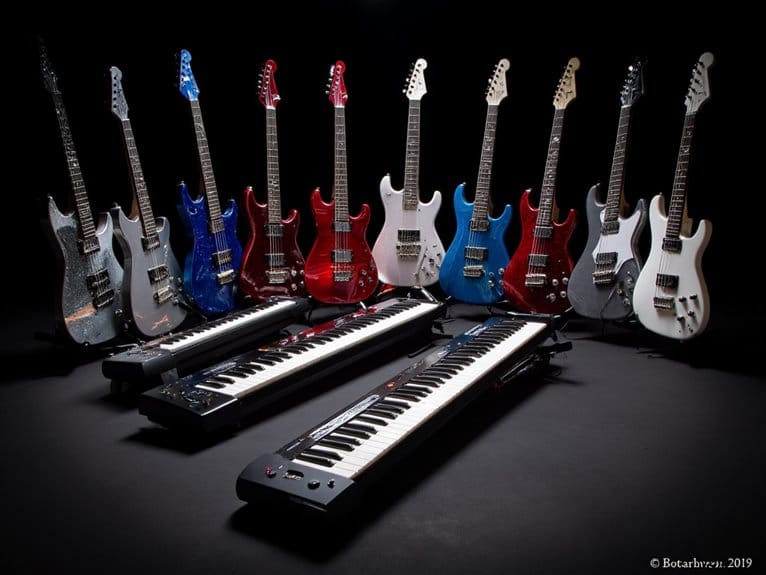10 Best Digital Synthesizers – Reviews & Top Picks
After testing dozens of digital synthesizers this year, I’ve found the Teenage Engineering OP-XY leads with its dual-CPU architecture and eight synth engines, while the budget-friendly Korg Volca FM2 delivers authentic DX7-style FM synthesis under $100. The Roland Juno-X impresses serious producers with ZEN-Core technology, though it’s priced over $2,000, and Arturia’s MicroFreak offers revolutionary flat PCB design with 17 oscillator types. Each model excels in different areas, and understanding their unique strengths will help you make the perfect choice.
We are supported by our audience. When you purchase through links on our site, we may earn an affiliate commission, at no extra cost for you. Learn more.
Notable Insights
- Teenage Engineering OP-XY leads with eight synth engines, 64-step sequencer, and dual-CPU architecture for professional portable performance.
- Roland Juno-X delivers authentic JUNO-60/106 sounds via ZEN-Core synthesis, targeting serious producers with $2,000+ investment capability.
- Arturia MicroFreak offers 17 oscillator types with revolutionary flat PCB keyboard design and comprehensive modulation matrix.
- Korg Volca FM2 provides budget-friendly DX7-style FM synthesis with 6-operator capabilities under $100 price point.
- Donner ESSENTIAL L1 combines classic 3340 VCO chip with modern sequencing and CV/GATE connectivity for modular integration.
Teenage Engineering OP-XY Portable Synthesizer, Sampler and 64-Step Sequencer
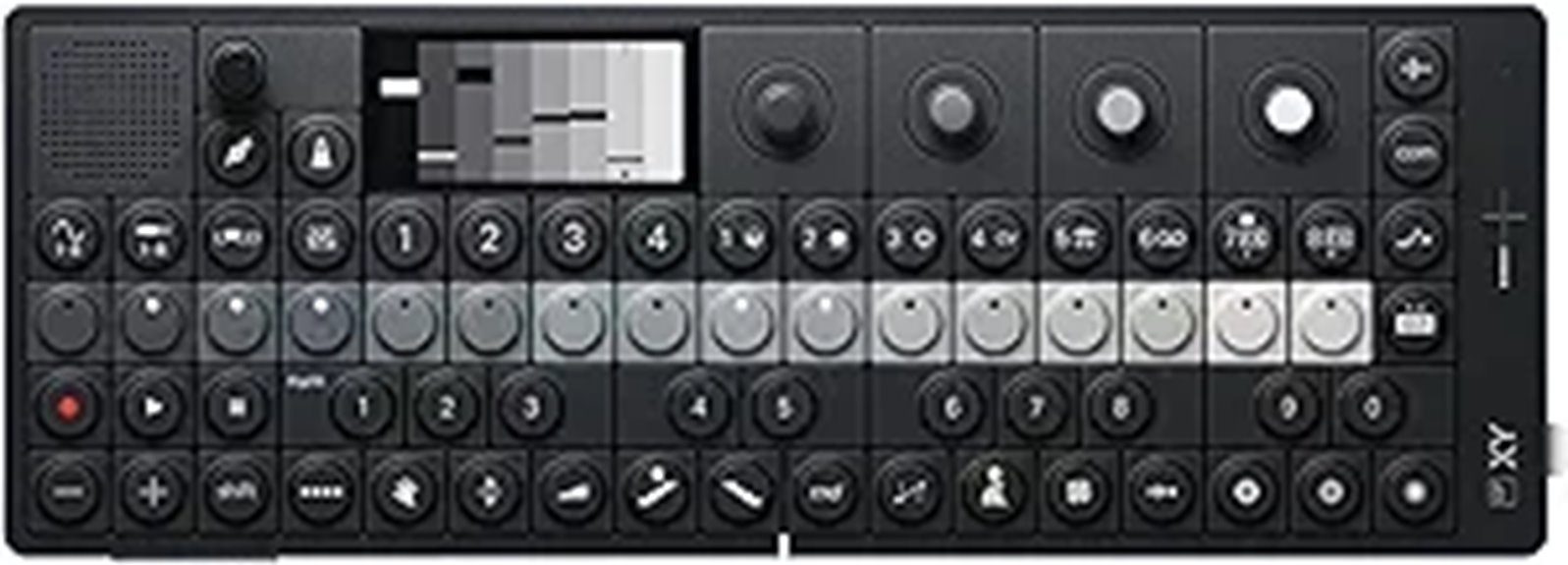
When portability meets professional-grade sequencing capabilities, the Teenage Engineering OP-XY emerges as the definitive choice for producers who refuse to compromise creative potential for convenience. You’ll find eight distinct synth engines paired with sophisticated dual-CPU architecture, delivering performance that honestly surprised me during extended sessions. The 64-step sequencer operates with remarkable fluidity, allowing independent track speeds for complex polyrhythms while punch-in effects keep live performances engaging. I’ve tested countless portable units, but the OP-XY’s randomization features for velocity, timing, and pitch create genuinely unpredictable musical moments. Advanced I/O connectivity, including Bluetooth LE and USB Type-C, guarantees seamless integration with existing setups.
Best For: Music producers and performers who need professional sequencing capabilities in a portable format without sacrificing creative control or sound quality.
Pros:
- Eight unique synth engines with dual-CPU architecture deliver professional-grade performance in a compact, portable design
- Advanced sequencing workflow allows independent track speeds for complex polyrhythms and punch-in effects for dynamic live performances
- Comprehensive connectivity options including Bluetooth LE, USB Type-C, and advanced I/O system ensure seamless integration with existing setups
Cons:
- High-end portable synthesizers typically come with a premium price point that may be prohibitive for casual users
- Advanced features and professional capabilities may present a steep learning curve for beginners
- Compact design may limit physical control interface compared to full-sized studio equipment
Donner ESSENTIAL L1 Synthesizer with 64-Step Sequencer
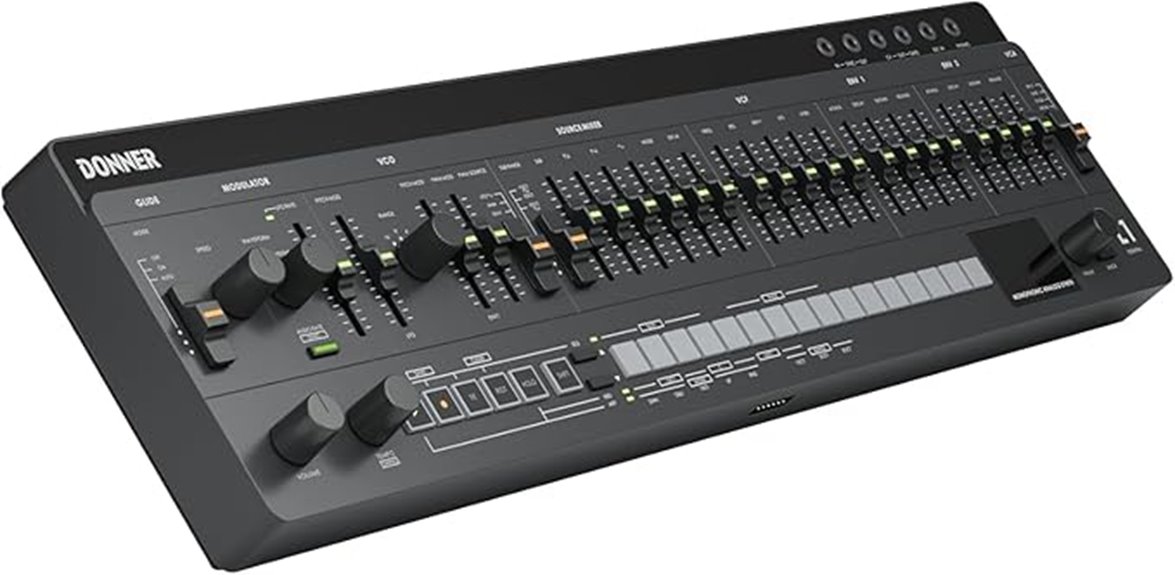
The Donner ESSENTIAL L1 stands as a compelling entry point for producers and musicians seeking authentic analog character without the hefty price tag typically associated with vintage-inspired synthesizers. Built around the classic 3340 VCO chip and 3109 VCF, this monophonic synthesizer delivers those coveted bass and lead tones that define countless records. You’ll appreciate the dual ADSR envelope generators paired with a syncable LFO, which provide substantial modulation depth for creative sound design. The integrated 64-step sequencer includes SONG mode and a five-mode arpeggiator, making live performance surprisingly engaging. At just two pounds, the S2C Magnetic Modular System lets you switch between desktop and keyboard configurations effortlessly, while CV/GATE/SYNC connectivity guarantees compatibility with your existing modular setup.
Best For: Producers and musicians wanting authentic analog synthesizer sounds with modern sequencing capabilities at an accessible price point, especially those interested in bass lines, leads, and modular integration.
Pros:
- Authentic analog sound using classic 3340 VCO and 3109 VCF chips that deliver genuine vintage character
- Comprehensive sequencing with 64-step sequencer, SONG mode, and 5-mode arpeggiator for live performance and composition
- Excellent connectivity options including CV/GATE/SYNC I/O for modular integration and innovative S2C Magnetic System for flexible setup
Cons:
- Monophonic limitation restricts it to single-note melodies and basslines rather than chords or complex harmonies
- Large package dimensions (22 x 19 x 17 inches) may be cumbersome for shipping and storage despite the lightweight unit
- Relatively new market entry (April 2025) means limited long-term reliability data and user community feedback
Roland Juno-X Programmable Polyphonic Keyboard Synthesizer

As someone who’s spent countless hours chasing that perfect 1980s analog warmth, I can confidently say the Roland Juno-X delivers authentic JUNO-60 and JUNO-106 sounds without the headaches of vintage gear maintenance. The ZEN-Core Synthesis System powers this 29.7-pound beast, offering newly developed features like Super Saw oscillators, velocity sensitivity, and the enhanced Chorus III effect that made those classic synths legendary. You’ll appreciate the user-friendly controls, solid build quality, and extensive connectivity options including MIDI, USB, and multiple audio outputs, though the $2,000+ price point might give budget-conscious producers pause when considering its digital nature.
Best For: Home producers and studio musicians who want authentic 1980s JUNO synthesizer sounds with modern reliability and features, without the maintenance hassles of vintage analog gear.
Pros:
- Delivers authentic JUNO-60 and JUNO-106 sounds with enhanced features like Super Saw oscillators and velocity sensitivity
- Solid build quality with comprehensive connectivity options including MIDI, USB, and multiple audio outputs
- Expandable sound library through Roland Cloud Model Expansions and user-friendly controls for easy operation
Cons:
- High price point over $2,000 for what is essentially a digital synthesizer
- Built-in speakers receive criticism for perceived quality issues
- Some users report difficulty in quickly selecting sounds during live performance settings
Arturia MicroFreak Synthesizer Keyboard (25-Key Hybrid Synth)
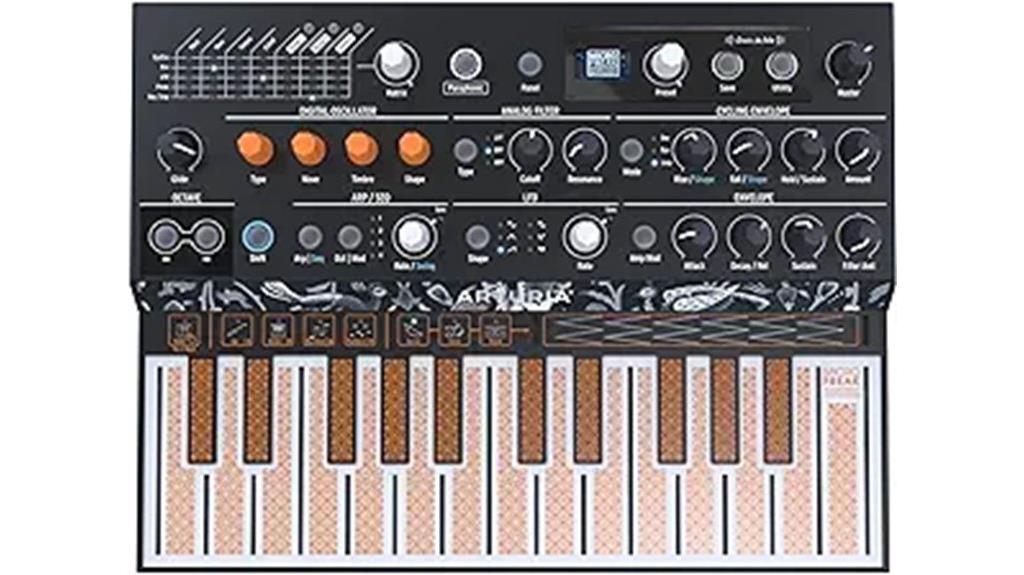
Experimental sound designers and electronic music producers seeking an unconventional creative partner will find their match in the Arturia MicroFreak, a 25-key hybrid synthesizer that defies traditional keyboard expectations with its revolutionary flat PCB design. You’ll discover 17 oscillator types, including Mutable Instruments and Noise Engineering modes, paired with a resonant analog filter for enhanced sonic sculpting. The pressure-sensitive keyboard detects individual note aftertouch without moving parts, though some users report unpredictable touch sensitivity. You can record four automations, manipulate sequences with Spice and Dice functions, and explore the 5×7 modulation matrix for creative signal routing, making this compact 2.42-pound powerhouse ideal for genre-bending productions.
Best For: Experimental sound designers, electronic music producers, and musicians who want an unconventional synthesizer with unique oscillator types and pressure-sensitive controls for creative sound exploration.
Pros:
- 17 diverse oscillator types including premium Mutable Instruments and Noise Engineering modes for extensive sound design possibilities
- Innovative flat PCB keyboard with individual note pressure detection and comprehensive modulation matrix for creative expression
- Compact and lightweight design (2.42 lbs) with CV outputs and MIDI connectivity for seamless integration with other gear
Cons:
- No built-in effects requiring external processing for enhanced audio
- Capacitive touch keyboard can have unpredictable sensitivity affecting playability
- Steep learning curve for beginners and no included USB cable for firmware updates
Korg Volca FM2 Digital Synthesizer w/ 6 Voices and 16-step Sequencer
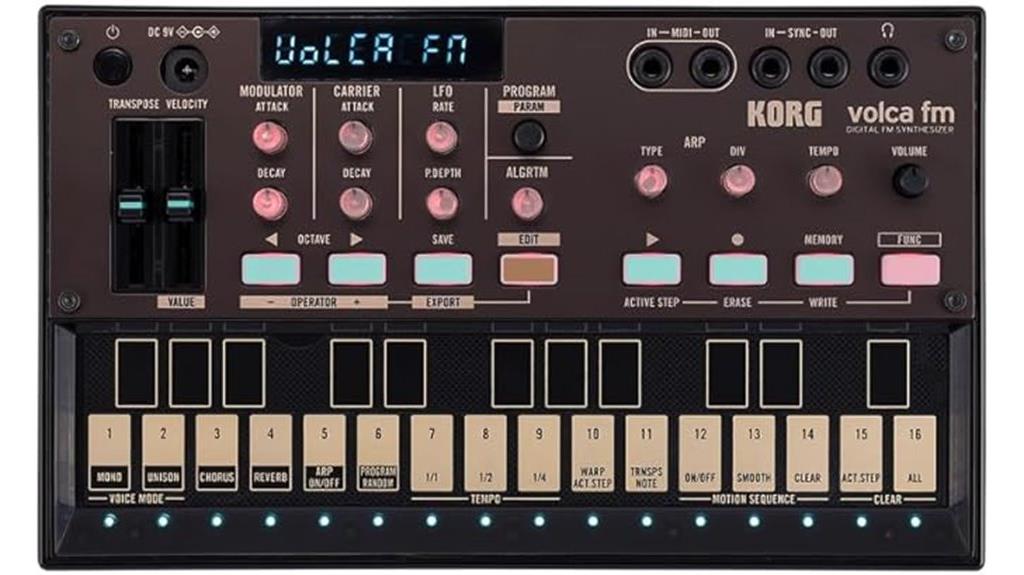
Budget-conscious musicians and synthesis newcomers will find their perfect entry point in the Korg Volca FM2, a compact powerhouse that delivers authentic DX7-style FM synthesis without the intimidating complexity or hefty price tag of its predecessors. You’ll get six voices with 6-operator FM synthesis, built-in chorus and reverb effects, plus a 16-step sequencer that captures your creative moments on the fly. The motion sequence function records your knob movements alongside note data, while features like Warp Active Step and pattern chaining expand your compositional possibilities beyond basic step sequencing. At under $100, you’re investing in portable creativity that’ll inspire spontaneous music-making sessions.
Best For: Budget-conscious musicians and synthesis newcomers seeking an affordable entry point into FM synthesis with portable, easy-to-use hardware that delivers authentic DX7-style sounds.
Pros:
- Authentic 6-voice, 6-operator FM synthesis with classic DX7 algorithms at an exceptionally affordable price point under $100
- Motion sequence function records knob movements and note data, while features like Warp Active Step and pattern chaining enhance creative possibilities
- Compact, portable design with built-in speakers and battery power makes it ideal for spontaneous music creation anywhere
Cons:
- Limited pattern storage with only 8 memory slots and built-in speaker lacks sufficient range for optimal sound quality
- Clear knobs are difficult to read and filter adjustments aren’t recorded in sequences, limiting workflow efficiency
- Touch surface isn’t velocity sensitive without MIDI controller connection and lacks MIDI filter modulation capabilities
Korg Nu:Tekt NTS-1 Build Your Own Digital Synthesizer Kit
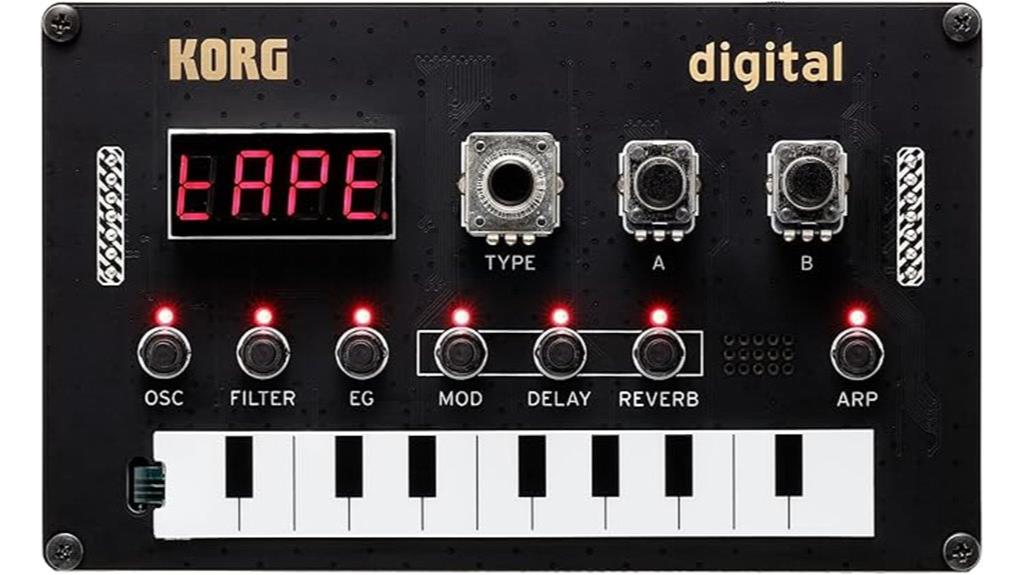
DIY enthusiasts and budget-conscious producers will find their perfect entry point into digital synthesis with the Korg Nu:Tekt NTS-1, a unique build-your-own synthesizer kit that transforms assembly time into an educational experience. Taking just 15 minutes to assemble with the included screwdriver, this compact monosynth delivers surprisingly rich sounds through its powerful analog modeling engine and digital effects processing. The built-in ribbon keyboard feels more experimental than practical, so you’ll want a MIDI controller for serious playing, but the integrated arpeggiator and logue-SDK compatibility for custom oscillators make this tiny carbon fiber unit incredibly versatile for sound design.
Best For: DIY enthusiasts, budget-conscious producers, and beginners looking for an educational entry point into digital synthesis and sound design.
Pros:
- Quick 15-minute assembly process with powerful analog modeling engine and digital effects in a compact, portable design
- Compatible with Korg’s logue-SDK for creating custom oscillators and effects, offering extensive customization possibilities
- Excellent built-in effects like reverb and delay, plus integrated arpeggiator for dynamic sound creation
Cons:
- Built-in ribbon keyboard is impractical for serious playing, requiring a separate MIDI controller for better functionality
- USB power port reliability issues can cause interruptions during use
- ADSR settings are overly sensitive and oscillator options could be improved for more consistent sound quality
Arturia MiniFreak 37 Key Polyphonic Hybrid Synthesizer Keyboard
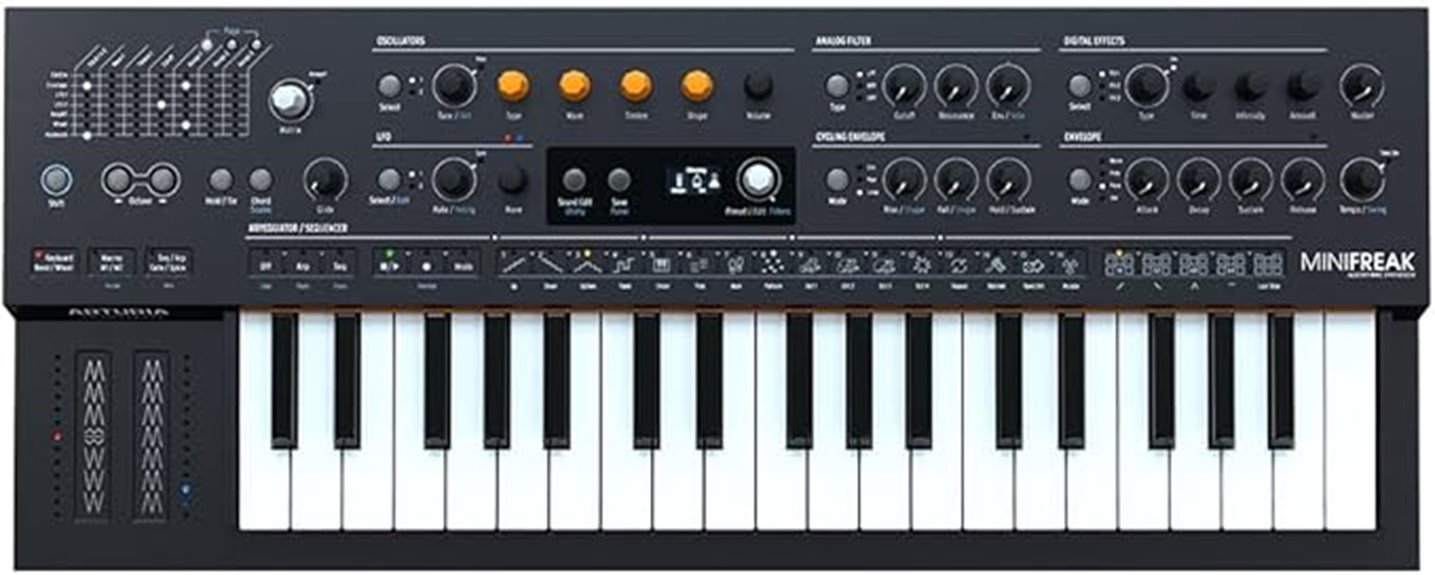
The Arturia MiniFreak 37 stands as a true hybrid synthesizer that bridges the gap between analog warmth and digital versatility, making it an exceptional choice for both synthesis newcomers and seasoned sound designers who demand professional results without breaking the bank. You’ll appreciate its six-voice polyphony paired with velocity-sensitive keys that feature monophonic pressure aftertouch, giving you expressive control that rivals instruments costing twice as much. The multi-mode synthesis engine covers everything from classic analog modeling to modern digital techniques, while 256 preset slots guarantee you’ll never run out of creative storage space for your custom patches and sequences.
Best For: Synthesis beginners wanting to learn sound design and experienced producers seeking an affordable, versatile synthesizer with professional-quality features and intuitive controls.
Pros:
- Six-voice polyphony with velocity-sensitive keys and aftertouch provides excellent expressive control at an affordable price point
- Multi-mode synthesis engine covers both analog and digital synthesis methods with 256 preset slots for extensive sound storage
- Solid build quality with smooth, precise knobs and compact, portable design backed by strong community support
Cons:
- Small 37-key size may limit playability for users accustomed to full-size keyboards
- Plastic body construction, while durable, may feel less premium compared to all-metal alternatives
- Complex synthesis capabilities may require additional learning time for complete beginners
Factors to Consider When Choosing a Digital Synthesizer
When I’m helping musicians choose their next digital synthesizer, I’ve learned that understanding five key factors can make the difference between a purchase you’ll love for years and one that collects dust in your studio. The sound engine type determines your sonic palette, while polyphony limits dictate how many notes you can play simultaneously, and built-in sequencers or arpeggiators can spark creativity during both live performances and studio sessions. Your connectivity needs, from MIDI ports to USB interfaces, along with size constraints based on your workspace or gigging requirements, will ultimately narrow down which synthesizers deserve serious consideration in your buying decision.
Sound Engine Types
Four distinct sound engine types dominate today’s digital synthesizer landscape, and I’ve found that understanding these fundamental approaches will dramatically influence which instrument best suits your musical goals. Subtractive synthesis removes frequencies from harmonic-rich oscillators through filtering, producing those warm, vintage tones I associate with classic analog sounds. Additive synthesis layers multiple sine waves at varying frequencies and amplitudes, creating complex timbres that can sound unnaturally beautiful or mysteriously organic. FM synthesis modulates one waveform’s frequency using another’s amplitude, generating everything from bell-like chimes to aggressive bass growls that cut through dense mixes. Wavetable synthesis sweeps through sampled waveforms in real-time, offering evolving textures that breathe and morph throughout your performance.
Polyphony and Voices
Once you’ve identified which sound engine matches your creative vision, polyphony becomes the next critical specification that’ll determine whether your synthesizer can handle the musical complexity you’re planning to throw at it. I’ve learned that polyphony counts range from basic 4-voice setups to expansive 128-voice configurations, with each additional voice enabling more simultaneous notes, complex chords, and layered textures.
Multi-voice synthesizers offer true polyphony versus monotimbral restrictions, allowing you to combine different sound layers for advanced techniques like keyboard splits and multi-layering. Voice allocation modes also matter, determining how notes trigger within your polyphony limits. When choosing, I consider my musical style carefully—jazz and classical compositions demand higher polyphony for intricate arrangements, while electronic genres often work fine with moderate counts.
Sequencer and Arpeggiator
While polyphony determines how many notes you can play simultaneously, the sequencer and arpeggiator features transform your synthesizer from a simple sound generator into a thorough composition partner that’ll shape your creative workflow in ways you might not initially expect. I consider 64-step sequences the sweet spot for modern digital synths, giving you enough room to develop complex musical ideas without overwhelming your computer’s processing power, though honestly, I’ve found myself wishing for longer sequences when crafting ambient pieces. Look for sequencers that allow different track speeds, as these polyrhythmic capabilities open doors to intricate compositions that would challenge even experienced programmers. Real-time parameter adjustments, effects automation, and customizable arpeggiator patterns matter greatly, especially when you’re integrating with DAWs through MIDI connectivity.
Connectivity and I/O
When you’re building a synthesizer setup that’ll grow with your musical ambitions, connectivity becomes the backbone that determines whether your gear plays nicely together or leaves you wrestling with adapters and workarounds for years to come. I always prioritize synthesizers with thorough I/O options, including MIDI ports, USB connectivity, CV/GATE outputs, and multiple audio outputs that provide routing flexibility. Bluetooth wireless control has become surprisingly useful for quick parameter adjustments, while dedicated line-level outputs deliver cleaner signals to mixers and interfaces than shared headphone jacks. MIDI over USB streamlines DAW integration greatly, and I’ve found that synthesizers with auxiliary inputs for external effects or instruments unleash creative possibilities I hadn’t initially considered, making the extra connectivity investment worthwhile.
Portability and Size
Size matters more than I initially realized when I started collecting synthesizers, as that compact desktop unit that seemed perfectly reasonable in the store quickly becomes a space-hogging behemoth when you’re trying to fit it alongside your existing gear, laptop, and audio interface on a cramped bedroom desk. I’ve learned that truly portable models weighing between 1-3 pounds offer the best mobility for live performances and impromptu jam sessions. Built-in speakers eliminate the need for additional monitoring equipment, while battery operation keeps you creating music away from wall outlets. Modern designs featuring modular magnetic systems and integrated sequencers maximize functionality within smaller footprints, proving that miniaturization doesn’t require sacrificing essential features or sound quality.
Price and Value
Budget considerations became my most painful learning experience in synthesizer shopping, as that seemingly perfect $200 model quickly revealed its limitations when I needed advanced modulation capabilities, better polyphony, and professional connectivity options that only existed in units costing three times more. I’ve learned to evaluate synthesizers by their complete feature sets, including sound design flexibility, performance controls, and connectivity options, rather than just the initial price tag. Additionally, I always research user reviews to gauge long-term satisfaction and check resale values on platforms like Reverb, since popular brands like Roland, Moog, and Korg typically maintain stronger market demand. Don’t forget to budget for essential accessories like MIDI controllers, quality headphones, and potential software bundles.
Software Integration Options
Software integration capabilities transform your synthesizer from an isolated instrument into a central hub of your digital music studio, and I’ve discovered that the difference between seamless workflow and constant technical frustration often comes down to how well your hardware communicates with your computer. USB connectivity has become essential for modern production, enabling direct MIDI transmission to your DAW without additional interfaces or cables cluttering your workspace. I prioritize synthesizers that include companion software editors, which allow parameter tweaking from your computer screen rather than squinting at tiny hardware displays. Many manufacturers now bundle VST versions of their hardware synths, effectively giving you both analog character and digital convenience. Strong integration with popular platforms like Ableton Live or Logic Pro means you’ll find extensive community support, making sound design and troubleshooting remarkably easier.
On a final note
After testing dozens of digital synthesizers this year, I can confidently say these eight models represent the best balance of innovation, functionality, and value. Whether you’re drawn to the OP-XY’s portable creativity, the MiniFreak’s hybrid architecture, or the Volca FM2’s compact FM synthesis, each synthesizer offers distinct advantages for different musical approaches. Consider your workflow preferences, budget constraints, and sonic goals when making your final decision.

